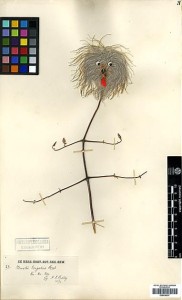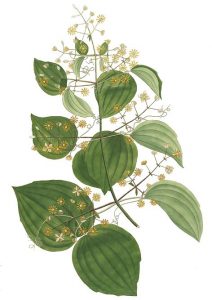As part of my project for the Flora of Nepal I am revising the species of Clematis and the closely related genus Naravelia that occur there. I spend a fair bit of time in the herbarium looking at old specimens and occasionally you come across odd things lurking in cupboards like this specimen of Clematis tangutica.
Clematis are a well-known group of flowering plants, being horticulturally significant. Many people grow the big blousy hybrids that flower profusely like Clematis ‘Nelly Moser ‘. That cultivar is so popular you can even decorate your wheely bin with stickers and this does lend itself to nerdy jokes about “bucket species” when giving presentations.
Naravelia are probably less well known as they come from more tropical climes and are not hardy in European gardens. They are distinguished from Clematis by having long, thin spoon like sepals and the terminal leaflets that are modified into tendrils. The tendrils help the plant be a more effective climber in the dense tropical habitats of India, southern Nepal and South East Asia.
Recent genetic work done by Japanese and Chinese researchers have shown that species of Naravelia are actually more closely related than previously thought and probably don’t justify being recognised as distinct from Clematis. However no one has yet taken the taxonomic plunge to move the seven or so species to the genus Clematis. I assume the reason for this is that for the two species, Naravelia pauciflora and N. siamensis, there are already species called Clematis pauciflora and Clematis siamensis. This means the two Naravelia species would require entirely new names.
If Naravelia is sunk into synonomy that will reduce the number of genera that occur in Nepal. The level of generic diversity in Nepal will drop by 0.06%! It seems odd that with all the effort that goes into trying to maintain levels of biodiversity through conservation, that a technicality is responsible for the extinction of an entire genus! However, the overall level of species diversity would remain the same as Clematis would gain a new species. Balance is restored.
There is often chat about ‘lumpers’ and ‘splitters’ in the world of taxonomy, but what about ‘stickers’? No I’m not referring to the bin again. It does seems like the path of least resistance to leave things as they are. I have a funny feeling though my supervisors might see things in a different light and make me to take the taxonomic plunge.
If you want to see the plant is question you’ll have to settle for the illustration from 1798 in William Roxburgh’s Plants of the coast of Coromandel. vol. 2. plate 188. Back then it was known as Atragene zeylanica, that’s what Carl Linnaeus originally called it.
So originally it was Atragene zeylanica, but is currently known as Naravelia zeylanica, but should probably be called Clematis zeylanica.
Clear?
Good.


